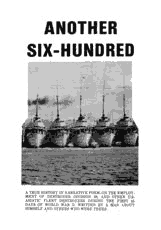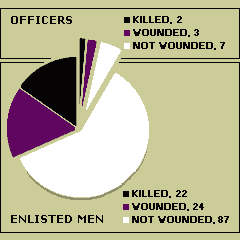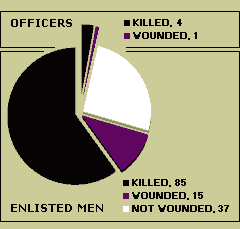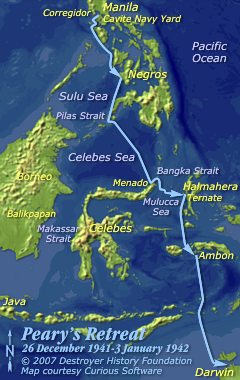

Containing perhaps the best narrative account of Peary in World War II.
One of 25 consecutively-numberedClemson-class flush-deckers built at Philadelphia’s William Cramp & Sons Ship & Engine Building Company, Peary was laid down 9 September 1919, the same day as sisters Stewart, DD 224, and Pope, DD 225. At her launch 6 April 1920, she was named for explorer RAdm. Robert E. Peary, who had passed away six weeks earlier, and christened by his daughter, Marie Peary Stafford.
Peary commissioned 22 October 1920 and in 1922 was sent to the Far East. Through 1931, she was assigned to the Yangtze Patrol Force; thereafter until World War II, she participated in the Asiatic Fleet’s annual deployments to Chinese waters as prewar flagship of Destroyer Division 59 (with Pope, Pillsbury, DD 227, and John D. Ford, DD 228), one of Destroyer Squadron 29’s three divisions.

Peary’s casualties. Above: 10 and 28 December 1941; below: 19 February 1942.
 Source: Bureau of Personnel casualty report, NARA.
Source: Bureau of Personnel casualty report, NARA.
Their attack set widespread fires and demolished the yard’s power plant, cutting power and water pressure on fire mains. One bomb hit Peary’s foremast, showering her with fragments and setting fires, killing eight and wounding many more including her commanding officer, LCdr. Harry H. Keith, who was hit in the knees. While undamaged Pillsbury backed clear from her berth across the pier, bucket brigades brought Peary’s fires under control and her crew removed the wounded.
Within the hour, however, fires in the yard spread to the wooden docks and adjacent warehouses, putting Peary at risk from exploding acetylene cylinders, torpedo air flasks and warheads. Not a moment too soon, Whippoorwill (AM 35) returned
from patrol to haul her clear. With Pillsbury joining in, the “Whip” played hoses on her, moored her to a buoy in nearby Cañacao Bay and removed her remaining casualties to the local hospital, for which Whipporwill’s CO, LCdr. Charles A. Ferriter, received a Navy Cross.
By the end of the day, Peary was operating under her own power. Over the next weeks, replacements were found for some of her crew and, under command of Lt. John M. Bermingham (who was awaiting orders home after completing a tour as Stewart’s XO), repairs needed to make her seaworthy (if not battleworthy) were made.
On 17 December, as the Japanese secured footholds on Luzon and Mindanano and air raids became an almost-daily event, most seaworthy ships at Cavite were released to sail south to safety. Peary and Pillsbury requested permission to join them but instead were formed with PT boats into striking forces under the direction of RAdm. Francis W. Rockwell. Two torpedo mounts were landed from each destroyer and each made a round-trip run to Mindoro—Peary with three PTs on 23 December.
Off Corregidor, 26 December, they were again attacked by air—Peary by fifteen high-altitude bombers in two groups. Maneuvering to evade, she was not hit but near misses did minor damage. Then RAdm. Rockwell finally granted permission to put to sea by the “best route” to join Task Force 5, then concentrating at Surabaya, Java. While Pillsbury took departure via an “outside route” for Balikpapan, Peary followed in the evening via an “inside route” south.

At 1000 on the 27th, Peary made Campomanes Bay, Negros Island, where her crew camouflaged her with green paint and palm fronds, hoping to elude Japanese patrol bombers. Underway to nearby Asia Bay after five enemy planes passed overhead without sighting her, she remained unobserved by five more planes in the afternoon. When darkness fell, she shaped a course through Pilas Strait in the Sulu Archipelago to the Celebes Sea, mistaking an island for an enemy cruiser en route and intending to continue southwest toward Makassar Strait.
On the 28th, while Pillsbury made Balikpapan without incident, Peary was attacked twice more.
In the morning, a four-engine plane first thought to be an American PBY began shadowing Peary as a report was received of the presence of enemy ships to the southwest, so Peary proceeded southeast toward Menado (Manado), Celebes (Sulawesi) and the small Dutch-Australian base at Ambon. At 1420, an hour after she sighted land, three other Japanese planes appeared. In a two-hour attack, the quartet dropped 500-pound bombs each; then two each dropped two torpedoes at a range of only 500 yards. With split-second timing, Peary backed her starboard engine and the first two torpedoes narrowly missed the bow; seconds later, the other two torpedoes passed up her starboard side about ten yards off as a third bomber approached from astern. As Peary put on speed to evade, its bomb fell 100 yards in her wake and she emerged with only strafing damage to her stacks.
Unknown to Peary, an Australian PBY from Ambon had also sighted her aircraft “escort” and, recognizing it as Japanese, misidentified her as Japanese also. Making landfall at Menado at 1645, it appeared the approach of darkness made it unnecessary to take shelter there. Instead, after inquiring by blinker whether Bangka Strait was mined but receiving no answer, Peary turned northeast into the passage inside Bunakeng (Bunaken) Island. There, off Kina (Kima) at 1800, three Australian Lockheed Hudson bombers appeared. Withholding fire, the crew cheered the sight of them until they commenced two bombing runs each. More accurate than the Japanese, their near misses killed one man by “friendly fire” (the phrase coined in Peary’s deck log). Two more were wounded as shrapnel peppered the ship, perforating the hull shell plating in several places including the steering compartment and parting the wheel ropes. A fourth was blown overboard by Peary’s own after 4-inch gun as the ship heeled in a sharp turn (he was rescued by a fishing boat and spent the war working coal mines in Japan).
Steering by hand, Peary resumed her course through Bangka Strait and then stood out to the south. By 2000, however, the starboard engine’s thrust bearing was found to be overheating and an examination revealed that the bearing had been wiped. As fuel was known to be low and an acute shortage of boiler feed water was also discovered, it was hoped these could be found at Dutch-held Ternate, colonial capital of the Halmahera region. Accordingly, after examining charts for a suitably deep shoreline surrounded by high land where she could be concealed, Peary sent a dispatch and shaped a new course east across the Molucca Sea, making 22 knots on her port engine.
It was after midnight, with the navigator conning and the captain steering from the after deck house, when she entered the narrow channel between Ternate’s island neighbor Tidore and tiny Maitara. At 0500 on the 29th, she tied up to palm trees on Maitara’s northeast side facing Ternate. There, so effectively camouflaged that friendly PBYs did not at first see her, she found fuel and took on water and stores as her engineers worked on the thrust bearing.
Underway once more for Ambon at 1830 on the 30th, Peary’s starboard thrust bearing again failed en route but at 1430 on the 31st she made Ambon Bay. Refueling overnight as the Australians apologized for attacking her, she took departure shortly after 1000 on New Year’s Day 1942 under the escort of now-friendly aircraft. Without charts of Australia, she anchored in Clarence Strait off Darwin at 1600 on the 2nd; then followed Parrott through the minefields to Port Darwin and anchored there at 0840, 3 January, with her crew hoping that their next destination would be the West Coast.
Meanwhile, it became apparent many of Peary’s crew had contracted what was later diagnosed as malignant malaria at Ternate. The disease having been eradicated elsewhere, the men had not been vaccinated against it. Twenty-eight crewembers were stricken of whom 8 eventually died.
Peary began operating from Darwin from 17 January on anti-submarine patrol, convoy and escort missions, including one to beleaguered Timor. On 15 February, she and Houston (CA 30) stood out as escorts for another convoy to Timor. Sighted, the convoy was attacked the following morning by 36 land-based bombers and 10 seaplanes, followed by reports that a carrier task force was also operating in striking range. Returning to Darwin, the convoy arrived on the morning of 18 February.
Ordered to join Admiral Doorman’s force (soon to be engaged in the Battle of the Java Sea), Houston and Peary immediately refueled. As they stood out of Port Darwin that evening, Peary picked up a submarine contact. A long search ended without result but consumed vital fuel. While Houston continued westward alone (to fight in the Battle of the Java Sea and be sunk in Sunda Strait 1 March), therefore, Peary was ordered back to Darwin again to top off. She stood in and anchored at 0100, 19 February.
Just before 1000 that morning, the first of 188 bombers from carriers Akagi, Kaga, Hiryu and Soryu plus 54 land-based bombers from Ambon began attacking the port. In combination, they sank eight ships and demolished the port, ending its usefulness as an Allied base.
As the first wave came in, William B. Preston (AVD 4, ex-DD 344) got under way and survived; nearby Peary, refueling from tanker British Motorist and unable to slip her anchor quickly, barely got underway and did not survive. Five bombs hit: the first exploded on the fantail, the second, an incendiary, on the galley deck house; the third did not explode; the fourth hit forward and set off the forward ammunition magazines; the fifth, another incendiary, exploded in the after engine room.
Even as she was sinking, a .30 caliber machine gun on the after deck house and a .50 caliber machine gun on the galley deck house continued firing until the last enemy plane departed, the last unknown gunner “firing even while the water rose . . . still at the gun controls—loading, aiming and firing, unaided—when the Peary went down stern first” at about 1300.
Eighty-nine officers and men including LCdr. Bermingham were killed in her sinking; 57 survived, 20 of whom were wounded. Peary was struck from the Navy List 8 May 1942 and received one battle star for World War II service; Captain Bermingham was posthumously awarded the Navy Cross.
On 8 April 1944, USS John M. Bermingham, Evarts-class DE 530, commissioned; decommissioned 12 October 1945, she was scrapped in 1946.
Meanwhile, in the 1950s, diver Carl Atkinson salvaged one of Peary’s four-inch guns. In 1992, it was emplaced in Darwin’s Bicentennial Park as the Peary Gun Memorial where, in 2001, a memorial service was conducted and a plaque dedicated on the 50th anniversary of the ANZAC Treaty. Pointing toward Peary’s final position, the gun is today an icon of enduring ties between Australia and the United States that date from the events surrounding her loss.
References: Deck logs, action reports and other records from the historical research of E. Andrew Wilde; Naval Historical Center: Dictionary of American Naval Fighting Ships; Roscoe; Darwin City Council Environment and Infrastructure Committee minutes.